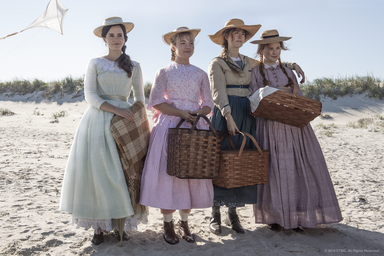This review contains mild spoilers for Little Women (which has been around for over 150 years, just saying).
When the topic of classic literature comes up, there is almost always a mention of Louisa May Alcott’s Little Women. Originally published in two volumes in 1868 and 1869, respectively, it tells the story of four young sisters – Meg, Jo, Beth, and Amy March – growing up in Civil War-era Massachusetts. It has been adapted to film over half a dozen times since 1917, its most recent reimagining written and directed by Greta Gerwig in 2019.
Since childhood, I have always loved historical fiction. My favourite was Anne of Green Gables (1908) by Lucy Maud Montgomery, but I also loved A Little Princess (1905) and The Secret Garden (1911), both by Frances Hodgson Burnett. When I was a bit older, I got into Jane Austen, Charles Dickens, and all those long-deceased British writers that English teachers worship.
Basically, I was like Bella Swan, but without the hot vampire boyfriend. Yet, despite my love for the classics, I never did get around to reading Little Women. Most editions contain over 750 pages, making it dauntingly lengthy, and to be frank, the plot just didn’t seem all that interesting.
The March sisters get along (save for the occasional sibling squabble), live in a comfortable, middle class home (call them poor all you want, but in my opinion, nobody with a servant is impoverished), and are well-cared for by both parents (I prefer my protagonists orphaned, not stirred). Although it is set during the Civil War, neither the reader nor any of the titular Little Women actually see much of the action. In fact, we only hear about the war because their father – the only character actively participating in it – is enlisted.
Nevertheless, I impulsively acquired a neat, paperback copy of Little Women during a visit to my local used bookstore, half-heartedly telling myself I’d get around to reading it someday just so I can say I did. It sat on my bookshelf for so long that when I finally decided to crack it open, there was actually a cobweb attached to it. It took me a few weeks to get through all 750+ pages, but to my surprise, I absolutely loved it. I finally understand the hype.
Little Women is heartwarming, philosophical, endearing, political, romantic, and hilarious all at the same time. Yes, it was written over 200 years ago, but its characters are so charming and funny that you feel as though you know them personally. Alcott was a phenomenal writer (dare I say, even better than Dickens – don’t @ me); much like Charlotte Bronte, she tends to drop the formality and directly addresses the reader at times or use “I” as a personal narrator, giving the novel a “bedtime story” feel. Contrary to my original complaint that nothing “bad” really happens to Meg, Jo, Beth, or Amy, it is actually quite refreshing to read a story about women who aren’t perpetually suffering.
Each of the sisters demonstrate the insecurities and difficulties of being a young woman at different stages of life. Meg, the eldest, is a desperate people-pleaser who longs to fit in with a higher social class and, despite their modern upbringing, aspires to traditional domesticity. Beth, the third eldest, has little to no ambition other than to embody kindness and good manners, which comes at a price later on. Jo and Amy, the second eldest and the youngest, respectively, are the two most complex and multifaceted characters. Whereas Jo is presented as the stereotypical tomboy who desires to be both socially and financially independent – like a man – she is shown to struggle with loneliness and professional rejections. Amy, on the other hand, is initially introduced as a vain, silly little girl, but later becomes a respectable young lady who refuses to be shamed for using her looks and manners to climb the social ladder.
Although it was written centuries ago, the problems encountered by the March sisters are still experienced by young women today, perhaps explaining why Little Women is still considered such a timeless tale. Alcott’s seminal novel suggests that no matter what “kind” of woman you are – whether you’re traditionally feminine and ladylike like Meg and Amy, or career-oriented and ambitious like Jo, it is not possible to please everyone. Each person has a different concept of the feminine ideal, so the journey to become the perfect woman is nothing but a fallacy.
If you’re a bookworm like me who once dismissed Little Women as Looking for Alaska (i.e., overrated book) of classic literature, I would highly recommend giving it a shot. Despite its length, anyone familiar with the language of classic literature will find it an easy read. If you’re just getting into the classics and looking to broaden your literary horizons, I would recommend Little Women for the same reasons. Although many classic junkies prefer the likes of A Tale of Two Cities (1859), or The Count of Monte Cristo (1844), the writing style and prose of Little Women is much easier to follow along with (SparkNotes not needed).
Then, once you’ve finished the book, you can watch the movie adaptations and join the rest of the internet in arguing about which actor portrayed a certain character best. In my most humble opinion, Timothée Chalamet was woefully miscast as the novel’s lead male character, Theodore “Laurie” Laurence. Sorry, not sorry.


